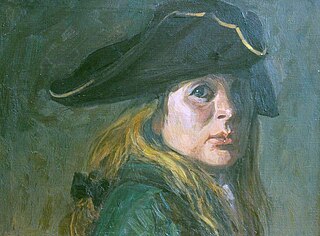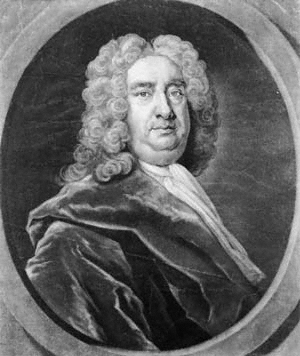
Henry Fielding was an English writer and magistrate known for the use of humour and satire in his works. His 1749 comic novel The History of Tom Jones, a Foundling was a seminal work in the genre. Along with Samuel Richardson, Fielding is seen as the founder of the traditional English novel. He also played an important role in the history of law enforcement in the United Kingdom, using his authority as a magistrate to found the Bow Street Runners, London's first professional police force.

James Lind was a Scottish physician. He was a pioneer of naval hygiene in the Royal Navy. By conducting one of the first ever clinical trials, he developed the theory that citrus fruits cured scurvy.

Scurvy is a disease resulting from a lack of vitamin C. Early symptoms of deficiency include weakness, fatigue, and sore arms and legs. Without treatment, decreased red blood cells, gum disease, changes to hair, and bleeding from the skin may occur. As scurvy worsens, there can be poor wound healing, personality changes, and finally death from infection or bleeding.

Vitamin C is a water-soluble vitamin found in citrus and other fruits, berries and vegetables. It is also a generic prescription medication and in some countries is sold as a non-prescription dietary supplement. As a therapy, it is used to prevent and treat scurvy, a disease caused by vitamin C deficiency.

Pierre Carlet de Chamblain de Marivaux, commonly referred to as Marivaux, was a French playwright and novelist.

Georg Wilhelm Steller was a German-born naturalist and explorer who contributed to the fields of biology, zoology, and ethnography. He participated in the Great Northern Expedition (1733–1743) and his observations of the natural world helped the exploration and documentation of the flora and fauna of the North Pacific region.

Christian August, Prince of Anhalt-Zerbst was a German prince of the House of Ascania, and the father of Catherine the Great of Russia.

Willem Jacob 's Gravesande was a Dutch mathematician and natural philosopher, chiefly remembered for developing experimental demonstrations of the laws of classical mechanics and the first experimental measurement of kinetic energy. As professor of mathematics, astronomy, and philosophy at Leiden University, he helped to propagate Isaac Newton's ideas in Continental Europe.

Nyasvizh or Nesvizh is a town in Minsk Region, Belarus. It serves as the administrative centre of Nyasvizh District. Nyasvizh is the site of Nesvizh Castle, a World Heritage Site. In 2009, its population was 14,300. As of 2024, it has a population of 15,968.

Maria Josepha of Austria was the Queen of Poland and Electress of Saxony by marriage to Augustus III. From 1711 to 1717, she was heiress presumptive to the Habsburg monarchy. Her sister Maria Amalia became Electress of Bavaria.

George Cheyne, M.D. R.C. E.d. R.S.S., was a pioneering physician, early proto-psychiatrist, philosopher and mathematician.

Pieter van Musschenbroek was a Dutch scientist. He was a professor in Duisburg, Utrecht, and Leiden, where he held positions in mathematics, philosophy, medicine, and astronomy. He is credited with the invention of the first capacitor in 1746: the Leyden jar. He performed pioneering work on the buckling of compressed struts. Musschenbroek was also one of the first scientists (1729) to provide detailed descriptions of testing machines for tension, compression, and flexure testing. An early example of a problem in dynamic plasticity was described in the 1739 paper.

The Sick and Hurt Commissioners were responsible for medical services in the Royal Navy. They were a separate body to the Navy Board, supplying surgeons to naval ships, providing them with medicines and equipment, and running shore and ship hospitals; they were also responsible for prisoners of war.

John Woodall (1570–1643) was an English military surgeon, Paracelsian chemist, businessman, linguist and diplomat. He made a fortune through the stocking of medical chests for the East India Company and later the armed forces of England. He wrote The Surgeon's Mate, the standard text to advise ships' surgeons about medical treatments while at sea. In the book he makes dietary recommendations which would have prevented the scourge of scurvy if they had been followed.

Lorenz Christoph Mizler von Kolof was a German physician, historian, printer, mathematician, Baroque music composer, and precursor of the Enlightenment in Poland.

The Great Northern Expedition or Second Kamchatka Expedition was one of the largest exploration enterprises in history, mapping most of the Arctic coast of Siberia and some parts of the North American coastline, greatly reducing "white areas" on maps. It was conceived by Russian Emperor Peter the Great, but implemented by Russian Empresses Anna and Elizabeth. The main organiser and leader of the expedition was Vitus Bering, who earlier had been commissioned by Peter I to lead the First Kamchatka Expedition. The Second Kamchatka Expedition lasted roughly from 1733 to 1743 and later was called the Great Northern Expedition due to the immense scale of its achievements.

Christian Gottlieb Ludwig was a German physician and botanist born in Brieg, Silesia. He was the father of physician/naturalist Christian Friedrich Ludwig (1757–1823) and of Christian L. Ludwig (1749–1784), a physician/scientist known for his translation of Joseph Priestley's scientific experiments.

Joshua Ward (1685–1761) was an English doctor, most remembered for the invention of Friar's Balsam. He sat briefly in the House of Commons from 1715 to 1717.

Robert Robertson (1742–1829) was a British surgeon and a Fellow of the Royal Society.

Jonas (Jean) Otter was a Swedish traveler in the Ottoman and Persian Empires, known for his book Voyage en Turquie et en Perse, avec une Relation des Expeditions de Tahmas-Kouli-Khan (1748), based on his ten years in the Middle East.




















